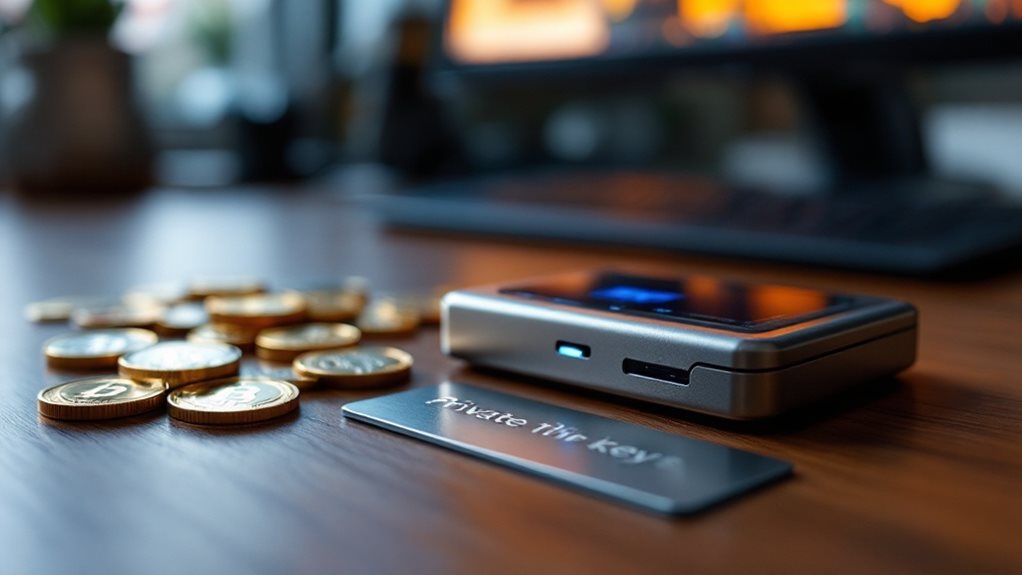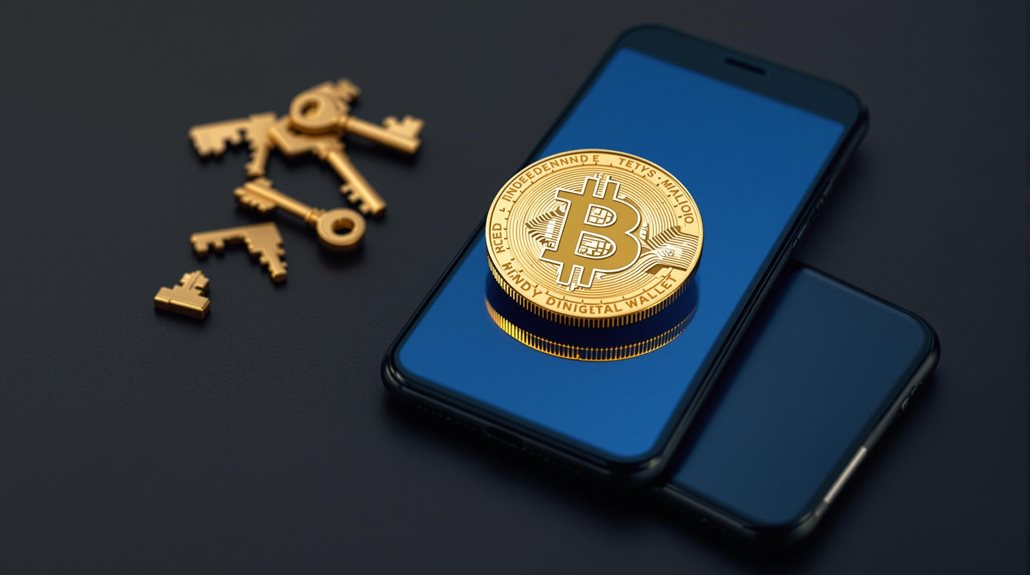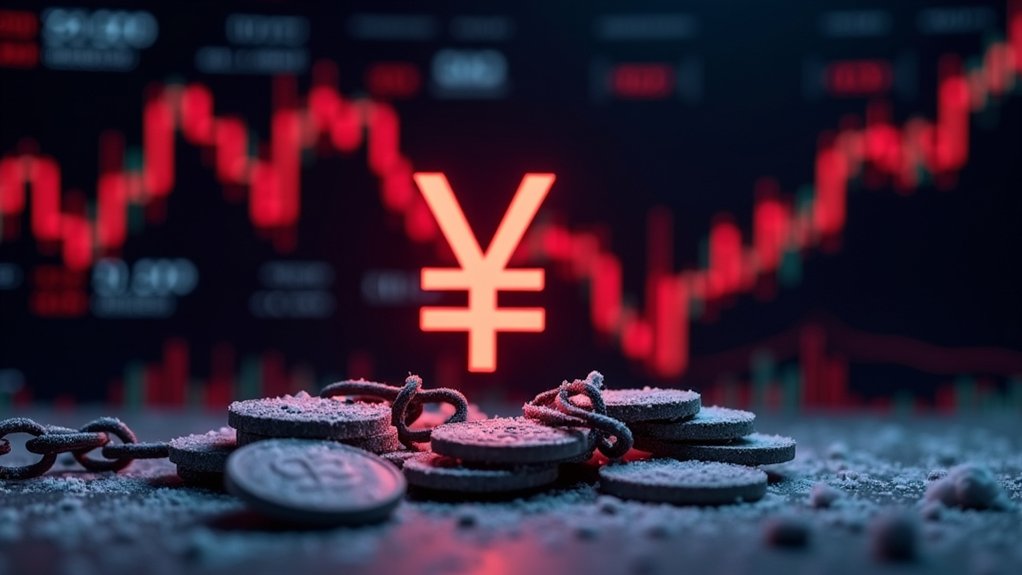A non-custodial wallet is a digital cryptocurrency wallet that gives users full control of their private keys and crypto assets. Unlike traditional exchanges or banks, there’s no third party holding or managing the funds. Users have direct access to their crypto and can make transactions independently on blockchain networks. While this offers enhanced security and privacy, it also means users are responsible for safeguarding their private keys. Understanding these wallets reveals important aspects of financial sovereignty.
Quick Overview
- A non-custodial wallet gives users complete control over their cryptocurrency by storing private keys directly on their device.
- Users maintain sole ownership of their private keys, following the principle “not your keys, not your coins.”
- These wallets operate independently of third parties, allowing direct peer-to-peer transactions without intermediary approval.
- Non-custodial wallets enhance security by protecting against exchange hacks but require users to manage their private keys responsibly.
- Users can transact instantly with lower fees, but losing private keys means permanent loss of access to funds.

A non-custodial wallet puts cryptocurrency control directly in the user’s hands. These wallets let users manage their digital assets without relying on any third-party companies or custodians. When someone uses a non-custodial wallet, they’re the only one who has access to their private keys, which are like special passwords that prove ownership of cryptocurrency. Many users choose to store their assets in cold storage wallets for enhanced security during long-term holding.
Non-custodial wallets align perfectly with blockchain’s core idea of decentralization. Popular examples include MetaMask, Trust Wallet, and Exodus. These wallets store private keys locally on the user’s device, giving them complete control over their funds. This setup means users don’t have to worry about exchange hacks or security breaches that often affect centralized platforms. The principle of not your keys, not your coins emphasizes why users should maintain control of their private keys. Most users are increasingly favoring these wallets, with 72% preferring non-custodial options for enhanced security.
Operating on peer-to-peer networks, these wallets enable direct transactions without intermediaries, making them a cornerstone of financial autonomy. The independence offered by non-custodial wallets comes with significant benefits for privacy. Users don’t need to share personal information with providers, and they can make transactions instantly without waiting for anyone’s approval. Many of these wallets also process transactions at very low costs and offer built-in features for trading cryptocurrencies directly through decentralized exchanges.
However, this level of control brings serious responsibility. If users lose their private keys or recovery phrases, there’s no customer support team that can help them regain access to their funds. In fact, about 20% of all Bitcoin, roughly 3.7 million BTC, has been lost forever because people forgot or lost access to their keys.
Non-custodial wallets provide strong security against centralized points of failure, but they do require some technical knowledge to use safely. Users need to understand how to properly store and protect their private keys, as well as how to navigate the wallet’s interface to send and receive cryptocurrency correctly.
These wallets operate differently from traditional banking services. They connect users directly to blockchain networks, allowing them to sign and broadcast transactions without intermediaries. This direct connection means users have complete sovereignty over their digital assets, but it also means they’re fully responsible for maintaining their security.
The rise of non-custodial wallets represents a shift toward individual financial sovereignty in the cryptocurrency space. While they offer unmatched control and security features, they also demand a higher level of responsibility from users. For those willing to learn and manage their own keys, these wallets provide a way to truly own and control their digital assets without depending on traditional financial institutions or centralized cryptocurrency exchanges.
Frequently Asked Questions
How Long Does It Take to Set up a Non-Custodial Wallet?
Setting up a non-custodial wallet typically takes between 5 to 30 minutes, depending on the type chosen.
Software wallets are quicker, usually taking 5-15 minutes, while hardware wallets need 15-30 minutes for initial setup.
The process includes downloading the app or connecting the device, creating or importing a wallet, generating security keys, and making a backup.
Network synchronization can take longer, sometimes several hours.
Can I Recover My Wallet if I Lose My Device?
Yes, it’s possible to recover a wallet after losing a device.
The key is having the seed phrase, which is like a special password made up of 12-24 words. As long as someone has kept their seed phrase safe, they can restore their wallet on any new device using compatible wallet software.
The recovery process is straightforward – users just need to enter their seed phrase into the new wallet to regain access.
What Happens to My Crypto if the Wallet Provider Goes Bankrupt?
If a wallet provider goes bankrupt, it won’t affect users’ crypto funds.
This is because non-custodial wallets don’t hold users’ assets – the crypto stays on the blockchain.
Users keep control of their private keys, so they can still access their funds even if the wallet company shuts down.
They’ll just need to use their seed phrase to switch to a different wallet app that’s compatible with their crypto.
Are There Transaction Limits on Non-Custodial Wallets?
Non-custodial wallets don’t have built-in transaction limits. Users can send, receive, or hold any amount of cryptocurrency they want.
They’re not restricted by third parties or wallet providers. However, practical limitations exist – like network congestion, high fees during busy times, and blockchain capacity.
Some countries are discussing regulations that might affect large transactions, but currently, users have full control over their transaction amounts.
Can I Connect Multiple Devices to My Non-Custodial Wallet?
Yes, users can connect multiple devices to their non-custodial wallet.
It’s done by using the wallet’s seed phrase to restore access on new devices. Many wallet providers offer apps for both phones and computers, and some include browser extensions for easy access.
While connecting multiple devices is convenient, each new connection means there’s more to protect. Some wallets might limit the number of devices that can be connected.





